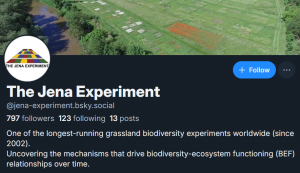New publication from Dietrich et al. in Ecology and Evolution: Linking plant diversity–productivity relationships to plant functional traits of dominant species and changes in soil properties in 15-year-old experimental grasslands
Positive plant diversity–productivity relationships are known to be driven by complementary resource use via differences in plant functional traits. Moreover, soil properties related to nutrient availability were shown to change with plant diversity over time; however, it is not well-understood whether and how such plant diversity-dependent soil changes and associated changes in functional traits contribute to positive diversity–productivity relationships in the long run. To test this, we investigated plant communities of different species richness (1, 2, 6, and 9 species) in a 15-year-old grassland biodiversity experiment. We determined community biomass production and biodiversity effects (net biodiversity [NEs], complementarity [CEs], and selection effects [SEs]), as well as community means of plant functional traits and soil properties. First, we tested how these variables changed along the plant diversity gradient and were related to each other. Then, we tested for direct and indirect effects of plant and soil variables influencing community biomass production and biodiversity effects. Community biomass production, NEs, CEs, SEs, plant height, root length density (RLD), and all soil property variables changed with plant diversity and the presence of the dominant grass species Arrhenatherum elatius (increase except for soil pH, which decreased). Plant height and RLD for plant functional traits, and soil pH and organic carbon concentration for soil properties, were the variables with the strongest influence on biomass production and biodiversity effects. Our results suggest that plant species richness and the presence of the dominant species, A. elatius, cause soil organic carbon to increase and soil pH to decrease over time, which increases nutrient availability favoring species with tall growth and dense root systems, resulting in higher biomass production in species-rich communities. Here, we present an additional process that contributes to the strengthening positive diversity–productivity relationship, which may play a role alongside the widespread plant functional trait-based explanation.
Reference:
Dietrich, P., Eisenhauer, N. and Roscher, C. (2023) Linking plant diversity–productivity relationships to plant functional traits of dominant species and changes in soil properties in 15-year-old experimental grasslands, Ecology and Evolution, 13(3), p. e9883. https://doi.org/10.1002/ece3.9883.



